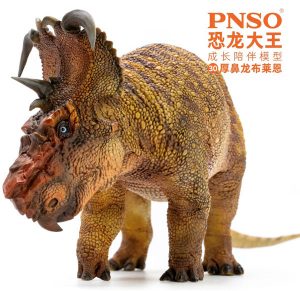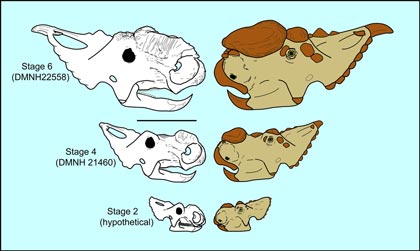Evidence of Baby Dinosaurs – Pachyrhinosaurus perotorum
Over the last few years a number of dinosaur discoveries from Upper Cretaceous sediments from well inside the Arctic Circle have provided palaeontologists with some remarkable data regarding dinosaurs living at high latitudes.
When asked to conjure up images of dinosaur fossil discoveries, most people might think of the Badlands of the western United States or the dusty, arid, inland areas of Mongolia, the frozen, bitterly cold wastes of Alaska do not readily spring to mind. However, a team of researchers from the Perot Museum of Nature and Science (Dallas, Texas), have been busy working their way through over ten tonnes of fossil material excavated from a site more than two hundred miles inside the Arctic Circle and they have been rewarded with the discovery of evidence of a juvenile dinosaur.
Juvenile Pachyrhinosaurus
A new species of Pachyrhinosaurus was named and described by Perot Museum scientists back in 2011 from a bone bed consisting of at least eleven individual specimens excavated from a quarry associated with the Prince Creek Formation (Upper Cretaceous). This new type of horned dinosaur was named Pachyrhinosaurus perotorum, the third species to be assigned to the Pachyrhinosaurus genus.
To read more about this discovery: New Species of Pachyrhinosaurus Announced.
In addition to finding fossils of adults, the scientists have identified portions of the skull from a juvenile. The presence of such a young dinosaur so far north suggests that far from migrating north each year to take advantage of the long days and good feeding opportunities the extra daylight brought, some dinosaurs may have been permanent residents coping with the harsh, cold winters at high latitudes.
Horned Dinosaur Fossil
Elements from the skull of the juvenile came from the same bone bed where the adult material was found. The site is known as the Kikak-Tegoseak Quarry and the rocks in this area represent material deposited by rivers, the strata has been dated to approximately 69 million years of age (Early Maastrichtian faunal stage).
North Alaska today is approximately 1,500 miles from the North Pole, however, back in the Late Cretaceous it was much closer, about 350 miles away, although the temperature was much warmer than today. Snow would have fallen occasionally but the landscape was dominated by extensive conifer forests with an understorey of hardy flowering plants and ferns. During that part of the year, when the North Pole faces the sun there would have been constant daylight. However, when the North Pole tilts away from the sun, northern Alaska would have endured the best part of four months in total darkness.
A Museum Quality Reconstruction of a Pachyrhinosaurus Specimen
To view models and replicas of Pachyrhinosaurus and other ceratopsians: PNSO Age of Dinosaurs Figures.
The field team organised the removal and transport of the large amount of fossil material, transporting it by air and road to the preparation laboratory at the Dallas-based museum. Dr Tykoski, the member of staff responsible for the fossil preparation work and his colleagues set about removing the fossils from the surrounding rock. The discovery of the juvenile dinosaur fossil material was made last year, when Dr Tykoski was working on a block of sediment about the size of a football.
Skull Elements
The fossils represent elements from the skull, an incomplete nasal bone. Fortunately, one of the key diagnostic features of this species of Pachyrhinosaurus is the area of skull represented by the nasal bone. The immature, juvenile specimen has a small, narrow, hardened patch on its snout, whilst in mature animals this area of the skull thickens into a large and bumpy boss. It has been suggested that these hardened and very thick parts of the skull were used in intra-specific head-butting contests between adults.
This newly described specimen, reported in a paper published in the online academic journal “PLoS One”, shows a mix of features in the nasal bone that helps palaeontologists to assess how skull characteristics of Ceratopsian dinosaurs changed as the animal grew. The specimen consists of an incomplete nasal bone that includes the rearward part of the nasal horn, the dorsal surface between the horn and the left-side contacts for the prefrontal and frontal bones, and some of the left side of the rostrum behind and slightly underneath in relation to the nasal horn.
The combination of morphologies in the new specimen suggests either an additional stage of development should be recognized in the ontogeny (growth and development) of the nasal boss of Pachyrhinosaurus, or that the ontogenetic pathway of nasal boss development in P. perotorum was notably different from that of other species within the Pachyrhinosaurus genus.
How the Skull Features of P. perotorum Grew and Developed
Picture credit: Perot Museum of Nature and Science
Pachyrhinosaurus perotorum
A series of Pachyrhinosaurus perotorum skulls (on the left) and stylized life reconstructions (on the right) at three (of a proposed six) different life stages. Stage 2 skull is based on juveniles of the closely related species Pachyrhinosaurus lakustai from southern Alberta. The Stage 4 skull represents a ‘partially grown’ or ‘early adolescent’ individual, based on the new specimen (DMNH 21460) discovered in 2012 by the museum preparation team. The Stage 6 skull is that of a mature adult, based on DMNH 22558, a nearly complete Pachyrhinosaurus perotorum skull described by Fiorillo and Tykoski in 2012 and currently on public exhibit in the Perot Museum of Nature and Science.
The ‘fleshed-out’ reconstructions are based on previously published ideas of Pachyrhinosaurus skin structures, but modified to reflect new information revealed by the new specimen (DMNH 21460). Light tan indicates ‘normal’ skin, while dark brown indicates cornified (= thickened, hardened, horn-tissue-covered) scales, horns, sheaths, or other cornified tissue. Scale bar equals 50 cm.
A Juvenile Specimen
Commenting on the discovery of juvenile Pachyrhinosaurus mateial Dr Tykoski stated:
“After a couple weeks of working on it, our question was ‘what on earth is this?’ It had features on it that looked like the big adult skull of the Pachyrhinosaurus perotorum that we had originally found, yet it was very narrow and skinny and didn’t have the big expanded nose of the adult. After ruling out all of the possibilities through the process of elimination, we realised this was a juvenile specimen. This provided us a snapshot in the development of the species – and that’s not common – so this was a very exciting moment for us.”
The finding of this juvenile specimen in and amongst the fossils of several adult animals has important ramifications. This suggests that either very young animals migrated northwards, or perhaps they may have been born somewhere on route to the feeding grounds. It also opens up the possibility that at least one species of large, herbivorous dinosaur was so at home in the harsh Alaskan environment that they were able to breed there and that they were perhaps permanent residents.
The Perot Museum of Nature and Science has already organised a number of return expeditions to North Alaska and the team have plans to study other likely fossil-bearing sites in a bid to learn more about these Late Cretaceous dinosaurs.
Three Different Species
At present, there are three different species of pachyrhinosaurs known, the last to be described was the Perot Museum’s North Alaskan discovery in 2011. The species are differentiated by different morphologies on the skull.
An Illustration Showing the Differences in Skull Morphology of Pachyrhinosaurus species.
Picture credit: Perto Museum of Science and Nature
Everything Dinosaur acknowledges the help of the Perot Museum of Nature and Science in the compilation of this article.








Leave A Comment